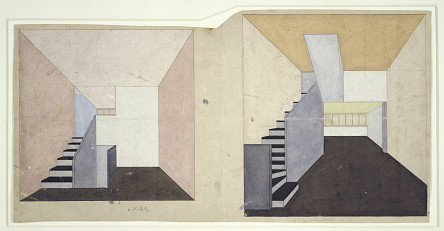
Scheper’s mural design shows the strongly architecture-related way in which he used colour.
Grey and grey-blue tones predominate in Hinnerk Scheper’s colourful mural design for an apartment in a residential building for Moscow officials. They give structure to the apartment’s staircase. By contrast, the side walls are left bright and become visually secondary. The colour design is organically linked to the building’s structure, making the architecture appear lightweight and almost dematerialized. A typical aspect for Scheper is the preference for light pastel colours rather than gaudy tones.
Scheper headed the Mural Painting Workshop starting in 1925, as the successor to Wassily Kandinsky and others. Whereas Kandinsky’s interest had focused on large-format, compositionally independent mural images, Scheper taught restraint in colour and the importance of its relation to the architecture. In Dessau, he developed a course for students that in the end was simply called ‘Colour’. He had a strong craft orientation and investigated not only color mixtures, but also colour types and colour substrates such as plaster. In 1929, the first Bauhaus wallpaper that was developed in the workshop went into industrial production. In 1955, Scheper commented, ‘It gave us an opportunity to transfer our own characteristic colouring, and a texture in the coloured surface that we had developed, from plaster to the paper. In this way, we were able to generalize our style of mural treatment and our principle of room design via mechanical reproduction and make it into an industrial product that was accessible to everybody and became popular.’
Although most of the work of the Mural Painting Workshop has not survived and the workshop has consequently remained little known, Bauhaus wallpaper became one of the college’s most successful works and is still being produced today.